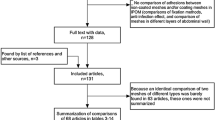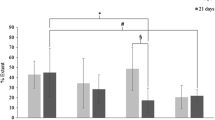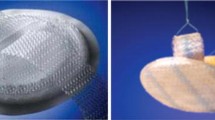Abstract
Background
Laparoscopic incisional hernia repair with intraperitoneal mesh is associated with a certain degree of adhesion formation to the mesh. This experimental study examined the efficacy of several coated meshes for adhesion reduction.
Methods
Five commercially available meshes with a layered coating were placed intraperitoneally in rats and followed up for 90 days: polypropylene and polyester meshes, both coated with absorbable collagen (Parietene Composite and Parietex Composite, respectively), and three polypropylene meshes respectively coated with absorbable omega-3 fatty acids (C-Qur Edge), absorbable cellulose (Sepramesh IP), and nonabsorbable expanded polytetrafluoroethylene (Intramesh T1). Uncoated polypropylene and collagen meshs (Parietene and Permacol, respectively) served as the control condition. Adhesions, incorporation, and tissue reaction were evaluated macro- and microscopically. Additionally, the development of the neoperitoneum was examined.
Results
All the coated meshes performed equally well in terms of adhesion reduction. The collagen mesh performed comparably, but the uncoated polypropylene mesh performed significantly worse. The different coatings led to very differing degrees of inflammation. Ingrowth was observed only at the place of suture but was comparable for all the meshes except C-Qur Edge, which showed the weakest incorporation. Development of a neoperitoneum on the mesh surface occurred independently of whether an absorbable or nonabsorbable coating or no coating at all was present.
Conclusions
Commercially available meshes with a layered coating deliver comparable adhesion reduction. The physical presence of a layered coating between the intraperitoneal content and the abdominal wall seems to be more important than the chemical properties of the coating in adhesion formation.


Similar content being viewed by others
References
Kuhry E, Schwenk WF, Gaupset R, Romild U, Bonjer HJ (2008) Long-term results of laparoscopic colorectal cancer resection. Cochrane Database Syst Rev (2):CD003432. doi:10.1002/14651858.CD003432
Burger JWA, Luijendijk RW, Hop WCJ, Halm JA, Verdaasdonk EGG, Jeekel J (2004) Long-term follow-up of a randomized controlled trial of suture versus mesh repair of incisional hernia. Ann Surg 240:578–583; discussion 583–585
Israelsson LA, Smedberg S, Montgomery A, Nordin P, Spangen L (2006) Incisional hernia repair in Sweden 2002. Hernia 10:258–261
Hawn MT, Snyder CW, Graham LA, Gray SH, Finan KR, Vick CC (2010) Long-term follow-up of technical outcomes for incisional hernia repair. J Am Coll Surg 210:648–655; discussion 655–657
Jenkins ED, Yom V, Melman L, Brunt LM, Eagon JC, Frisella MM, Matthews BD (2010) Prospective evaluation of adhesion characteristics to intraperitoneal mesh and adhesiolysis-related complications during laparoscopic reexploration after prior ventral hernia repair. Surg Endosc 24:3002–3007
Ellis H (2005) Intraabdominal and postoperative peritoneal adhesions. J Am Coll Surg 200:641–644
Muysoms FE, Bontinck J, Pletinckx P (2011) Complications of mesh devices for intraperitoneal umbilical hernia repair: a word of caution. Hernia 15:463–468
ten Broek RPG, Schreinemacher MHF, Jilesen APJ, Bouvy N, Bleichrodt RP, van Goor H (2012) Enterotomy risk in abdominal wall repair: a prospective study. Ann Surg 256:280–287
Schreinemacher MHF, ten Broek RP, Bakkum EA, van Goor H, Bouvy ND (2010) Adhesion awareness: a national survey of surgeons. World J Surg 34:2805–2812
Bellón JM, García-Honduvilla N, López R, Corrales C, Jurado F, Buján J (2003) In vitro mesothelialization of prosthetic materials designed for the repair of abdominal wall defects. J Mater Sci Mater Med 14:359–364
Deeken CR, Faucher KM, Matthews BD (2012) A review of the composition, characteristics, and effectiveness of barrier mesh prostheses utilized for laparoscopic ventral hernia repair. Surg Endosc 26:566–575
Van’t Riet M, van Steenwijk PJ, Bonthuis F, Marquet RL, Steyerberg EW, Jeekel J, Bonjer HJ (2003) Prevention of adhesion to prosthetic mesh: comparison of different barriers using an incisional hernia model. Ann Surg 237:123–128
Conze J, Junge K, Klinge U, Weiss C, Polivoda M, Oettinger AP, Schumpelick V (2005) Intraabdominal adhesion formation of polypropylene mesh: influence of coverage of omentum and polyglactin. Surg Endosc 19:798–803
Schreinemacher MHF, Emans PJ, Gijbels MJJ, Greve J-WM, Beets GL, Bouvy ND (2009) Degradation of mesh coatings and intraperitoneal adhesion formation in an experimental model. Br J Surg 96:305–313
Burger JWA, Halm JA, Wijsmuller AR, ten Raa S, Jeekel J (2006) Evaluation of new prosthetic meshes for ventral hernia repair. Surg Endosc 20:1320–1325
Gaertner WB, Bonsack ME, Delaney JP (2010) Visceral adhesions to hernia prostheses. Hernia 14:375–381
Chelala E, Debardemaeker Y, Elias B, Charara F, Dessily M, Allé J-L (2010) Eighty-five redo surgeries after 733 laparoscopic treatments for ventral and incisional hernia: adhesion and recurrence analysis. Hernia 14:123–129
Judge TW, Parker DM, Dinsmore RC (2007) Abdominal wall hernia repair: a comparison of sepramesh and parietex composite mesh in a rabbit hernia model. J Am Coll Surg 204:276–281
Zinther NB, Wara P, Friis-Andersen H (2010) Shrinkage of intraperitoneal onlay mesh in sheep: coated polyester mesh versus covered polypropylene mesh. Hernia 14:611–615
Rodríguez M, Pascual G, Sotomayor S, Pérez-Köhler B, Cifuentes A, Bellón JM (2011) Chemical adhesion barriers: do they affect the intraperitoneal behavior of a composite mesh? J Invest Surg 24:115–122
Sanchez VM, Abi-Haidar YE, Itani KMF (2011) Mesh infection in ventral incisional hernia repair: incidence, contributing factors, and treatment. Surg Infect Larchmt 12:205–210
Hawn MT, Gray SH, Snyder CW, Graham LA, Finan KR, Vick CC (2011) Predictors of mesh explantation after incisional hernia repair. Am J Surg 202:28–33
Boutros C, Somasundar P, Razzak A, Helton S, Espat NJ (2010) Omega-3 fatty acids: investigations from cytokine regulation to pancreatic cancer gene suppression. Arch Surg 145:515–520
Fortelny RH, Petter-Puchner AH, Glaser KS, Offner F, Benesch T, Rohr M (2010) Adverse effects of polyvinylidene fluoride-coated polypropylene mesh used for laparoscopic intraperitoneal onlay repair of incisional hernia. Br J Surg 97:1140–1145
Klink CD, Junge K, Binnebösel M, Alizai HP, Otto J, Neumann UP, Klinge U (2011) Comparison of long-term biocompability of PVDF and PP meshes. J Invest Surg 24:292–299
DuBay DA, Wang X, Adamson B, Kuzon WM, Dennis RG, Franz MG (2005) Progressive fascial wound failure impairs subsequent abdominal wall repairs: a new animal model of incisional hernia formation. Surgery 137:463–471
Acknowledgments
The meshes were supplied unconditionally by the respective manufacturers, whereas none of these were involved in the study design or analysis of results.
Disclosures
Marc H. F. Schreinemacher, Kevin W.Y. van Barneveld, Rieky E. G. Dikmans, Marion J. J. Gijbels, Jan-Willem M. Greve, and Nicole D. Bouvy have no conflicts of interest or financial ties to disclose.
Author information
Authors and Affiliations
Corresponding author
Rights and permissions
About this article
Cite this article
Schreinemacher, M.H.F., van Barneveld, K.W.Y., Dikmans, R.E.G. et al. Coated meshes for hernia repair provide comparable intraperitoneal adhesion prevention. Surg Endosc 27, 4202–4209 (2013). https://doi.org/10.1007/s00464-013-3021-5
Received:
Accepted:
Published:
Issue Date:
DOI: https://doi.org/10.1007/s00464-013-3021-5




